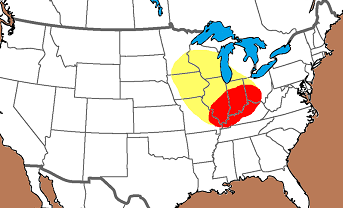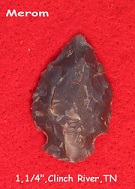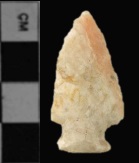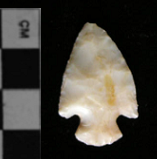Other Websites with Detailed Information:
Name Details:
Named By: Howard D. Winters
Named For:
Date Identified: 1969
Type Site: Wabash Valley, Illinois
Merom
(Riverton Series)
Cluster: Merom Cluster
Commonly Utilized Material:
Locally available cherts commonly utilizing heat treatment
Date:
Cultural Period:
3,600 - 2,800 B.P.
Late Archaic
Neoglacial
Late Archaic Riverton Culture
Glacial Period:
Culture:
Outline is Representative of Size and Shape:
Description of Physical Characteristics and Flaking Pattern:
This is a small triangular corner notch to expanding stem point. The cross section may vary from elliptical to lenticular. The blade may vary
from straight (more common in the related Trimble point) to excurvate (more common in the Merom point),
commonly with fine serrations. The shoulders are primarily horizontal, but may vary to a slight barb to a having a
slight upward slope. The stem is
expanding and is commonly short. The base is primarily straight, but may vary to convex
with rounded basal corners. The base is commonly beveled, but
rarely has hafting region grinding present. This point
is manufactured using both percussion and pressure flaking forming a random
flaking pattern.
Size Measurements: Total Length - 19 to 36 mm,
Stem Length - 5 to 9 mm, Blade Width - 11 to 20 mm, Neck
Width -6 to 12 mm, Stem Width - 7 to 14 mm, Thickness -
4 to 8 mm
Distribution:
Distribution Comments:
This point is primarily associated with the Riverton Culture of the
Wabash Valley and into the Ohio River Valley and the Illinois River
Valley. Red is representative of the normal distribution of the
Riverton culture and the distribution provided by Justice (1987).
Morrow (2016) notes that these points are commonly found in southern and
southeastern Minnesota which would be represented by the yellow
distribution.

Additional Comments:
The Trimble point may be types as a Merom Expanded (Justice / Kudlaty, 1999). Both points are commonly found together. The difference is that Trimble points commonly has a straight blade while the Merom
point has a excurvate blade. The Trimble point tends to have a longer and narrower blade than the Merom point. Trimble points tend to have a higher quality of workmanship than the Merom point. It is
thought that the Trimble point may be an early variant of the Merom point (Justice, 1987).
Point Validity: Valid Type
Winters is a distinguished
anthropologist who did extensive research in Illinois. He identified this point during the survey of the Wabash Valley in Illinois. This point was named in a professional publication and has many professional references. This is a valid type.
.
Age Details:
References: (See Reference Page, Entry Number):
17,
23, 30, 37, 168, 179
Merom Projectile Point, Merom Arrowhead









